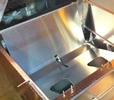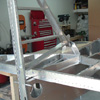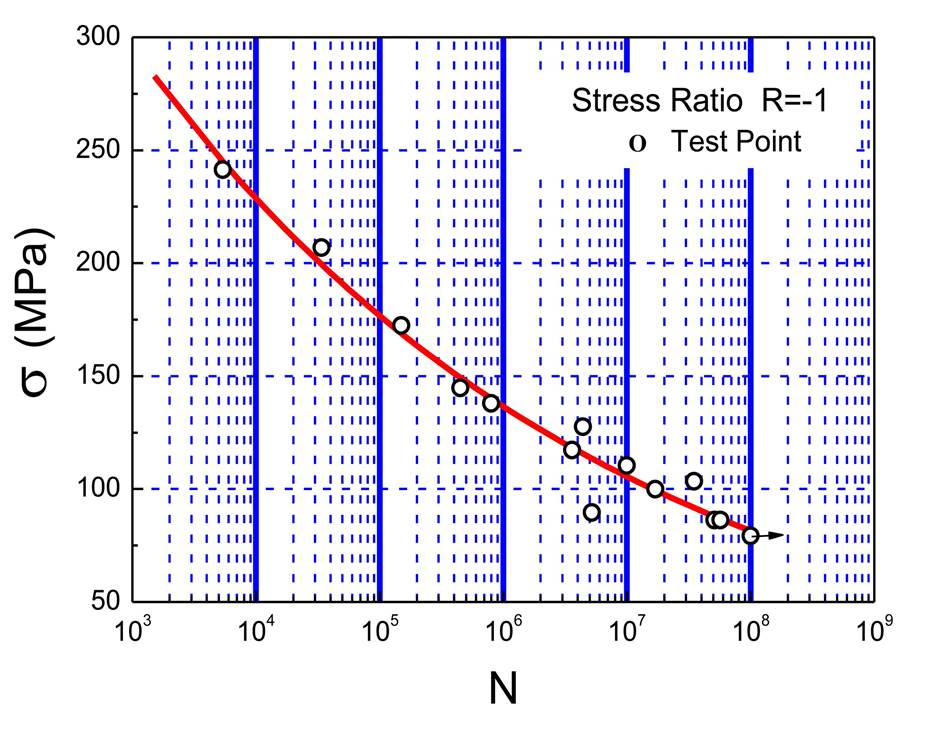


random user submitted photo
What is the fatigue life of a Sonex?
8 posts
• Page 1 of 1
What is the fatigue life of a Sonex?
Well, I certainly can't answer that question because it depends on so many different factors, but there has been a fair bit of discussion recently about the pros and cons of fitting heavier engines and flying with a greater maximum all up weight so I thought I'd toss in a bit of information about one of the consequences of increasing the weight of your Sonex.

The above graph shows stress against number of cycles to failure. It's not necessarily for 6061-T6 but it is a typical for S-N curve for aluminium. You'll notice that the bottom scale is logarithmic, not linear. If you pick any particular stress and then add just 10% to it, say by going from 200 MPa to 220 MPa, it results in roughly a halving of the fatigue life.
You could argue that the Sonex is so strong that fatigue will never be a problem, and you could be right. I certainly have confidence in my Sonex but there is a weak point, even in those massive main spars, and it's not hard to increase all the stresses by 10%. For example, by increasing the MAUW from 1150 pounds to 1250 pounds, an increase of 8.7%, you are actually increasing all the loads by about 9.6% (the weight of the wings doesn't count as part of the load). If you'd like to read about this in a bit more detail, go to my blog at http://capiloengineeringcom.fatcow.com/sample-page/other-stuff-of-interest/how-strong-is-the-sonex/
Peter
Sonex 894
357 hours and going strong

The above graph shows stress against number of cycles to failure. It's not necessarily for 6061-T6 but it is a typical for S-N curve for aluminium. You'll notice that the bottom scale is logarithmic, not linear. If you pick any particular stress and then add just 10% to it, say by going from 200 MPa to 220 MPa, it results in roughly a halving of the fatigue life.
You could argue that the Sonex is so strong that fatigue will never be a problem, and you could be right. I certainly have confidence in my Sonex but there is a weak point, even in those massive main spars, and it's not hard to increase all the stresses by 10%. For example, by increasing the MAUW from 1150 pounds to 1250 pounds, an increase of 8.7%, you are actually increasing all the loads by about 9.6% (the weight of the wings doesn't count as part of the load). If you'd like to read about this in a bit more detail, go to my blog at http://capiloengineeringcom.fatcow.com/sample-page/other-stuff-of-interest/how-strong-is-the-sonex/
Peter
Sonex 894
357 hours and going strong
- peter anson
- Posts: 558
- Joined: Thu Jul 31, 2014 2:34 am
- Location: Mount Macedon, Australia
Re: What is the fatigue life of a Sonex?
Hi Peter,
Really enjoyed reading your article and trying to understand how the Sonex will age. I wonder what the highest Sonex airframe time is and whether that person has noted any cracks due to fatigue.
Really enjoyed reading your article and trying to understand how the Sonex will age. I wonder what the highest Sonex airframe time is and whether that person has noted any cracks due to fatigue.
- SP1
- Posts: 120
- Joined: Sat Sep 10, 2016 2:04 am
Re: What is the fatigue life of a Sonex?
The longest I have heard of is a bit over 2000 hours and no cracks as far as I know, but you won't see them in the location I discussed without removing the wings. I was really worried when I first found the bulges on the fuselage floor but a pretty careful inspection revealed no problems and the Solidworks model supplied a good explanation. I have written a bit more guff on fatigue and specifically how it might apply to a Sonex at http://www.ansoneng.com/sample-page/other-stuff-of-interest/fatigue-of-metal-aircraft/
Peter
Peter
- peter anson
- Posts: 558
- Joined: Thu Jul 31, 2014 2:34 am
- Location: Mount Macedon, Australia
Re: What is the fatigue life of a Sonex?
I used to work in fatigue test at Sikorsky. Fatigue is a critical field in helicopters as the important parts are often spinning. The loads we analyze for are typically one per rev and N per rev, where N is the number of rotor blades. We had a metlab test material coupons to determine the curve shapes of the material. One size definitely does not fit all for aluminum or any other alloy. We would run the parts at accelerated loads until we initiated a crack. Then we would sometimes do crack propagation studies at normal loads.
Consider a helicopter with 4 blades that spins them at 300 RPM. Our one per rev frequency is 5 times a second and the N per rev is 20 times a second. We accrue a lot of fatigue damage due to the large amount of cycles. There are also big cycles which happen infrequently. Once per takeoff, you go from 0 G of load on the main rotor to 1 G, and from zero torque to max torque. That also accrues fatigue damage but at a low rate for normal flying. Metal does not care if it carries a load for a millisecond or a millennium. It is the cycles which matter.
Your 6.9 load probably accrued some fatigue damage. But it is hopefully a once in a lifetime event. A hardcore acro person might average 20 high G events per hour over the life of their Sonex. That is a lot less than 20 cycles per second as seen on a helicopter. Somebody just flying around probably accrues no fatigue damage. That is the big plus of fixed wing compared to helicopters.
The Schweizers had determined that when you design an airplane to meet static load requirements, fatigue was really no issue. They didn't have a fatigue lab but used an older conservative design criteria. That does not necessarily cover us for every airplane, as we see military hardware and large airplanes suffer from fatigue. But their gliders and recon aircraft span a range that would cover our Sonex.
Nice job with the modeling and deflection analysis Peter!
Consider a helicopter with 4 blades that spins them at 300 RPM. Our one per rev frequency is 5 times a second and the N per rev is 20 times a second. We accrue a lot of fatigue damage due to the large amount of cycles. There are also big cycles which happen infrequently. Once per takeoff, you go from 0 G of load on the main rotor to 1 G, and from zero torque to max torque. That also accrues fatigue damage but at a low rate for normal flying. Metal does not care if it carries a load for a millisecond or a millennium. It is the cycles which matter.
Your 6.9 load probably accrued some fatigue damage. But it is hopefully a once in a lifetime event. A hardcore acro person might average 20 high G events per hour over the life of their Sonex. That is a lot less than 20 cycles per second as seen on a helicopter. Somebody just flying around probably accrues no fatigue damage. That is the big plus of fixed wing compared to helicopters.
The Schweizers had determined that when you design an airplane to meet static load requirements, fatigue was really no issue. They didn't have a fatigue lab but used an older conservative design criteria. That does not necessarily cover us for every airplane, as we see military hardware and large airplanes suffer from fatigue. But their gliders and recon aircraft span a range that would cover our Sonex.
Nice job with the modeling and deflection analysis Peter!
Bryan Cotton
Poplar Grove, IL C77
Waiex 191 N191YX
Taildragger, Aerovee, acro ailerons
dual sticks with sport trainer controls
Prebuilt spars and machined angle kit
Year 2 flying and approaching 200 hours December 23
Poplar Grove, IL C77
Waiex 191 N191YX
Taildragger, Aerovee, acro ailerons
dual sticks with sport trainer controls
Prebuilt spars and machined angle kit
Year 2 flying and approaching 200 hours December 23
-

Bryan Cotton - Posts: 5496
- Joined: Mon Jul 01, 2013 9:54 pm
- Location: C77
Re: What is the fatigue life of a Sonex?
Of course, there is also the recent loss of the ERAU Cherokee. They had a fatigue initiation from an outboard spar mount hole. Wing departed after takeoff.
Bryan Cotton
Poplar Grove, IL C77
Waiex 191 N191YX
Taildragger, Aerovee, acro ailerons
dual sticks with sport trainer controls
Prebuilt spars and machined angle kit
Year 2 flying and approaching 200 hours December 23
Poplar Grove, IL C77
Waiex 191 N191YX
Taildragger, Aerovee, acro ailerons
dual sticks with sport trainer controls
Prebuilt spars and machined angle kit
Year 2 flying and approaching 200 hours December 23
-

Bryan Cotton - Posts: 5496
- Joined: Mon Jul 01, 2013 9:54 pm
- Location: C77
Re: What is the fatigue life of a Sonex?
Bryan Cotton wrote:That also accrues fatigue damage but at a low rate for normal flying. Metal does not care if it carries a load for a millisecond or a millennium. It is the cycles which matter.
Bryan - I agree with your philosophy here, but I think you have over-simplified it slightly, and left out an crucial part of the equation for everyone playing along at home. If I'm not mistaken, fatigue life is limited by the result of cumulative damage from load cycles as you suggest, however, we cannot overlook the importance of the amount of damage caused by each cycle which varies due to input loads. "Duty-cycle" is the term I'm familiar with...
A 6 G load accumulates more damage than many, many, many more 2 G loads, right? I think that is why Mr. Anson reminded us of the log scale, and that it is a S/N 'curve' and not S/N 'line', since fatigue loading is not a linear relationship.
In context, a generic 9 G 'rating' (likely just shy of the actual over-load condition) I believe really describes a single event (cycle), correct?
I don't mean to take away from your contribution and explanation of fatigue for the subscribers, but I'd like to help expand understanding as well, so somebody tell me if I'm wrong.
Here's my main point:
Perhaps most importantly, we all should consider that these rating type tests are typically performed with a single data point (think manufacturer/designer expense here - how many times do you need to prove you pass a test since each test destroys the part?). Our mileage (or in this case, expected rated aerobatic "capacity") will vary depending upon our skill levels, and how close to exactly duplicating the original test assembly we can achieve as we build. Part variations due to manufacturing and assembly tolerances tend to wreck all our statistical information on fatigue failure analyses. As Mr. Anson suggests, the curve he provided represents 'typical' aluminum. These curves comes from a group of material 'coupons' tested (to failure) to get a statistical representation of that material. Confidence in the known fatigue life goes down as assembly complexity increases (beyond the homogeneous coupon). That fact has disturbed me no-end as I read through the engine durability comparison / justification threads. Apples and potatoes... we need to be aware of the complexities of the data presented in forums like these.
Sonex N857SX
AeroVee, Taildragger, Dual Stick
AeroVee, Taildragger, Dual Stick
- achesos
- Posts: 33
- Joined: Tue Sep 22, 2015 9:19 pm
- Location: Delavan, Wisconsin
Re: What is the fatigue life of a Sonex?
This is all fun discussion. This is what I did for a couple years of my career.
This is true, but if you pull a steady 6G load for a millennium, you accumulate the same damage as pulling 6G for a millisecond. Both are one cycle.
It is worth noting that each alloy of aluminum (or steel, ti, whatever) has its own curve shape. A big aerospace company will fatigue test several samples of the structure or part to get several data points. The curve shape is used to determine the strength of the part using its test fracture data. A knockdown is taken to allow for material and workmanship variations which is more conservative than the demonstrated fatigue life.
I think what you are calling duty cycle would be referred to as flight profile in my former job. It is a best guess and is something agreed to by the FAA or military customer. There is risk that if you go out if the profile, you may be accruing more fatigue damage than allotted for and may have an early failure. Besides G it can also be a heavier gross weight. This brings us back to Peter's discussion.
A 6 G load accumulates more damage than many, many, many more 2 G loads, right?
This is true, but if you pull a steady 6G load for a millennium, you accumulate the same damage as pulling 6G for a millisecond. Both are one cycle.
It is worth noting that each alloy of aluminum (or steel, ti, whatever) has its own curve shape. A big aerospace company will fatigue test several samples of the structure or part to get several data points. The curve shape is used to determine the strength of the part using its test fracture data. A knockdown is taken to allow for material and workmanship variations which is more conservative than the demonstrated fatigue life.
I think what you are calling duty cycle would be referred to as flight profile in my former job. It is a best guess and is something agreed to by the FAA or military customer. There is risk that if you go out if the profile, you may be accruing more fatigue damage than allotted for and may have an early failure. Besides G it can also be a heavier gross weight. This brings us back to Peter's discussion.
Bryan Cotton
Poplar Grove, IL C77
Waiex 191 N191YX
Taildragger, Aerovee, acro ailerons
dual sticks with sport trainer controls
Prebuilt spars and machined angle kit
Year 2 flying and approaching 200 hours December 23
Poplar Grove, IL C77
Waiex 191 N191YX
Taildragger, Aerovee, acro ailerons
dual sticks with sport trainer controls
Prebuilt spars and machined angle kit
Year 2 flying and approaching 200 hours December 23
-

Bryan Cotton - Posts: 5496
- Joined: Mon Jul 01, 2013 9:54 pm
- Location: C77
Re: What is the fatigue life of a Sonex?
Damage accrual is just a mathematical way of accounting for crack growth with different load cycles. If a part lasts 1000 cycles at a particular load and you do 100 cycles of that load then you have used 10% of the life. If it lasts 10000 cycles at another load and you do 500 cycles at that load then you have used up another 5% of the life. As Bryan has pointed out, the problem for helicopters is that they do an awful lot of load cycles, but that can be a problem for fixed wing aircraft too. Engine vibration quickly adds up to many load cycles on an engine mount. I don't do aerobatics so probably the biggest loads I put on my Sonex are when flying in turbulence. The loads are generally not that big but there are lots of them.
I guess the point that I wanted to make in my original post was that it is pretty easy to shorten the (unknown) fatigue life of a Sonex, or any aircraft, by increasing the loads. I can understand how John Monnett feels about people changing his design. I was once present at the proof loading of a structure in a test rig I had designed and was aghast when the task manager decided on the spur of the moment to increase all the loads by 10% without clearing the rig for the higher loads, which I could have done in 15 minutes at my computer, but not instantly in my head. It survived but I have never seen such big bits of steel bend so far before, and nobody was going to die if the rig broke.
Peter
I guess the point that I wanted to make in my original post was that it is pretty easy to shorten the (unknown) fatigue life of a Sonex, or any aircraft, by increasing the loads. I can understand how John Monnett feels about people changing his design. I was once present at the proof loading of a structure in a test rig I had designed and was aghast when the task manager decided on the spur of the moment to increase all the loads by 10% without clearing the rig for the higher loads, which I could have done in 15 minutes at my computer, but not instantly in my head. It survived but I have never seen such big bits of steel bend so far before, and nobody was going to die if the rig broke.
Peter
- peter anson
- Posts: 558
- Joined: Thu Jul 31, 2014 2:34 am
- Location: Mount Macedon, Australia
8 posts
• Page 1 of 1
Who is online
Users browsing this forum: No registered users and 47 guests







